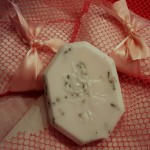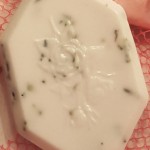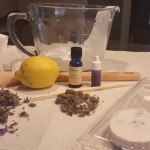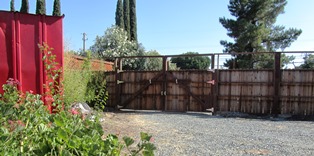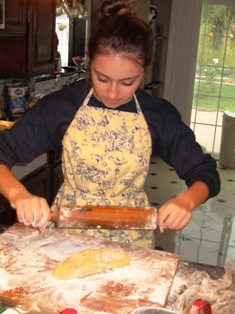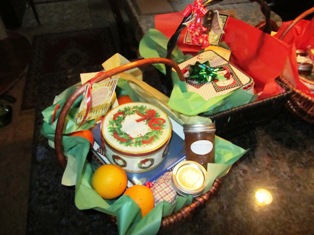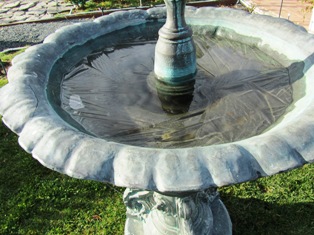Archive for the 'Crafts' Category
Making Homemade Soap in Under an Hour
My grandmother grew up on a farm in Boone County, Missouri, and from spending a childhood with her I learned how to be frugal, self-sufficient, and someone who values time and efficiency.
On laundry day, she would whip out a big bar of grayish soap she’d made from an old country recipe and use it for scrubbing dirty clothes. The soap contained lye, grease, ammonia, borax, and water.
It looked like an ash-colored cake; I wouldn’t be surprised if it had some ash in it. That soap was utilitarian to be sure, but nothing you’d ever want use for a bath, although I suppose on occasion it might have been used.
Bath soaps have come a long way since the 1920s frugal creations of farm folks like my grandmother. Today, you can find exquisite artisan soaps–many are imported from France, Italy, and elsewhere–in a variety of colors, shapes, sizes, and scents. Or . . . you could make your own.
At hobby and craft stores, you’ll find soap-making kits that provide the basics for making soap in under an hour. You’ll also need some soap color to give your soap an appealing hue (otherwise, the soap comes out white). Finally, drops of your favorite essential oil will give your soap a sensual fragrance.
Recently, the birthday of a friend inspired me to quickly make a few bars of bath soap to wrap and tuck in my “spa” gift package for her. If you haven’t made soap before, start with a kit for soap making such as the one sold by ArtMinds and found in craft stores.
That particular kit uses a goats milk recipe with a suspension formulation that allows additives to float freely throughout the soap. This is important when you want to add to the soap rose or other flower petals or herbs like basil, lavender, or mint. The finished bar of soap lathers luxuriously and leaves your skin feeling squeaky clean.
Lavender-Scented Soap Using the ArtMinds Kit
Ingredients:
1 Goats Milk Soap Kit with 32 scored cubes
1 package of soap-making color (comes with blue, green, and purple); use purple for lavender soap
Lavender essential oil
Plastic sheet of soap molds
*Wooden spoon
*Pyrex glass measuring bowl or microwavable dish
*Do not reuse soap-making utensils or bowls for food service.
Directions:
Remove 10 cubes of “raw” soap formulation. Melt the cubes in a large glass measuring bowl for 30 seconds; if not completely melted, microwave in 10-second increments.
Add drops of lavender color until the desired hue is achieved. Add ten drops of lavender essential oil. Stir to thoroughly mix ingredients.
Pinch off the tiny florets of a sprig of fresh lavender. Drop into the soap and gently blend them in.
Pour the soap to the top of the mold(s). Let set for 20 minutes before removing the hardened soap. I suggest wrapping each soap individually to give as gifts.
For more resources, check out Marie Browning’s book, Natural Soapmaking (Sterling Publishing, NY) or visit Rebecca’s Soap Delicatessen at http://soapdelinews.com/2015/07/how-to-make-cold-process-soap-from-scratch.html
____________________________________________________
If you’re interested in farmette topics and storytelling, check out my Henny Penny Farmette series of mysteries. All three books in the series are available in numerous formats and can be ordered from Amazon, Barnes and Noble, and elsewhere online as well as from traditional bookstores everywhere. See more at http://tinyurl.com/ya5vhhpm
Buying Fair Trade Generates More than Good Taste
We all love our local farmers’ markets where the freshest organic ingredients–direct from the farm to our tables–are easy to find and purchase. And they taste so good. But sometimes, we consumers desire something grown beyond America’s borders, such as tea, coffee, exotic spices, and chocolate. And this is where choice and purchasing power has consequences.
When you choose to buy products displaying a FAIR TRADE certification logo, your action directly and positively impacts the lives of farmers, growers, artisan craftspeople, commodities producers, and their workers in communities in developing nations.
As consumers demand better products and better working conditions for workers, the Fair Trade movement has more clout to lobby on behalf of commodity farmers, impoverished workers, and child laborers.
If you love chocolate, consider this: seventy percent of the world’s cocoa beans is produced in Cote d’Ivoire and other Western African countries. Pay is nominal at $2 USD/per dieum and, according to UNICEF, more than a half million children labor under dire working conditions in the cocoa fields in these bean-producing countries even though child labor is illegal in the cocoa industry.
Coffee was one of the first Fair Trade certified products but today’s consumers can now also find Fair Trade certified cocoa, wine, cotton, fruit, tea, red palm oil, coconut oil and associated products, chocolate, honey, quinoa and other ancient grains, beans, sugar, and bananas, to name a few items.
The Fair Trade Movement has been around since mid last century. It began as a mainly North American/European social movement to aid poor farmers, commodity producers, and laborers in developing nations to achieve more favorable trading conditions. Fair Trade also promotes sustainability.
Choosing to buy a product carrying the Fair Trade certification label means your consumer decision will impact more than your taste buds–it will have positive ramifications for workers, commodity producers, and their communities beyond America’s borders.
Building an Expensive Estate Fence for Next to Nothing
Over the last week, my husband build an eight-foot-tall estate fence across the front of our property. When I wasn’t writing or doing other chores, I helped. We’re big believers in recycling, so naturally, when it came to the fence, we found a way to build it without cutting down a single new tree and use lumber that might otherwise go into landfill.
The idea for the fence is to have something beautiful and functional. We now have a fence next to the street and an interior fence. Between the two fences is a spacious half circular driveway where our cars and trucks can enter, leave, or park.

The new fence is 110 feet long with two gates, one opens for cars and the opens to the curved stone walkway
We were given some 6-by 6 posts (about 70 of them) by a friend working in demolition. A lot of useable pressure treated lumber came in the same delivery. We had saved fence boards we bought four years ago and, in an unbelievable stroke of luck, we had enough to cover the entire fence except for the very last 16-board section.

The wooden gate swings wide open to permit a vehicle or heavy machinery access (I’m thinking a boat would be nice)
Our plan is to add trellises on top of each fence section and install large wrought iron gates that will open electronically. For now, we just have an opening at one end of the fence for our curved stone path leading to the front door. The wooden gate at the far end of the fence will permit a truck or car to enter the back of the property.
By stacking the 6-by-6 boards on top of each other and drilling them together in place, Carlos made what amounts to planter boxes for the bamboo that line the property.
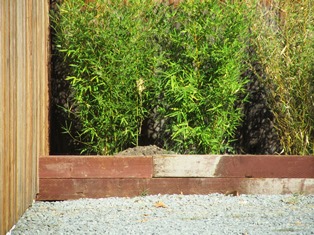
Stacked 6-by-6-foot lumber holds bamboo. Although one board needs staining, we don’t complain because the lumber was free
Crafts You Can Make from Your Backyard Garden
Invariably, when fall and winter holidays roll around each year, I find myself wishing that I’d planned ahead and utilized more raw materials from the garden for gift-giving. If you have had a similar experience, here are some ideas for turning what you grow into heart-warming gifts.
At summer’s end, harvest the seeds of your favorite flowers like cosmos, sunflowers, nasturtiums, zinnias, and even vegetables. Dry and re-package into paper envelopes that you hand-stamp, emboss, or otherwise embellish for gift-giving. Be sure to include information about how to grow the plant.
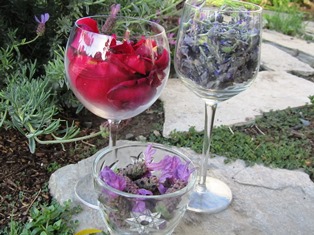
Rose petals, Spanish lavender, and French perfume lavender can be used to make a flower essences or potpourri
Flowers and herbs, picked at their zenith, can be turned into potpourri, fragrant soaps, soothing lotions, and skin moisturizers.
If you keep bees in your backyard garden, consider using the extra wax for dipping candles. Of course, honey is highly prized for its healthful properties, so be sure to jar up plenty of honey for gift-giving occasions.
Vines, berries, and pine cones are easily transformed into wreaths and dry arrangements.
A bottle of vodka, gin, or other spirits can be transformed into a gourmet gift by the addition of sun-ripened berries, herbs, vegetables (such a cucumber), or fruits and then stored in a dark, cool place for at least six weeks.
Gourds make lovely bird feeders and bird houses.
Just imagine the delight a dried-pepper wreath, a garlic braid, or jars of dried beans and seeds might evoke.
Make sheets of homemade paper, incorporating colorful rose petals, lavender, or pansies. Making paper is easy if you have a blender, some scraps of paper (junk mail works), and water.
Seed cakes, created from crunchy peanut butter, seeds, nuts, and dried fruit, make great gifts for bird lovers who can place them near feeders during the cold months when the bird must vigorously forage for food.
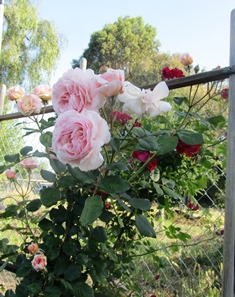
Re-potted cuttings of your garden favorites make lovely gifts for other gardeners in your family or circle of friends
Take cuttings in fall or early spring from your roses, dip the cuttings into root hormone, and plant the cuttings into a pot of soil that you keep damp until the roots have formed. Or dig bulbs (bearded irises, for example) and place in a tin for gift-giving.
Preserve jars of pie-filling, do up crocks of pickles, or create mouth-watering chutneys and special relishes. Wrap the jar lids in gingham and ribbon. Use hot-water canning of fruit and citrus into jam, jelly, and marmalade. Place jars of these items into a food basket, made festive with the addition of colorful tea towels or tissue paper and ribbon.
Use clean, dry corn husks for tamale-making, or craft them into corn husk dolls.
With a little forethought and advance planning, you’ll have plenty of backyard bounty to harvest and turn into gifts for almost any holiday or special occasion.
Sugar Cookies for Santa and the Elves
Everyone needs a little help during the holidays. An elf or two can make all the difference when you are trying to decorate the tree, hang stockings, and make all those special treats for Santa. I am baking dozens of batches of cookies to put into decorative tins that will then be tucked into baskets of other edible and gift items.
My book, Why Santa Wears Red, http://tinyurl.com/chp9sua (Fall River Press 2009), includes suggestions for things you can find in your back yard to decorate the house. In that book, I also include recipes for traditional fruitcake, cranberry scones, and fragrant herbal tea. But sugar cookies and pumpkin spiced cupcakes are two of my favorite holiday snacks.
Sometime during the summer, I purchased Nick Malgieri’s book, Cookies Unlimited and found a terrific sugar cookie recipe in it that I am using this year. It makes five dozen cookies per batch.
The ingredients are basic items (flour, sugar, and butter, for example) that you will probably have on hand if you like baking cookies. The texture is lovely and the cookies come out great every time. We iced them with a butter cream frosting and decorated with sprinkles before the icing could harden.
I enlisted help with the baking this year from family members. They also did the decorating and I packaged everything into the gift baskets. Each basket contains a few different items, depending on the family to receive them. In some, I tucked in one or two of my books, packets of seeds from my plants (like sunflowers, nasturtiums, zinnias, and marigolds), jars of apricot, white peach, or strawberry jam, and honey.
You might also add candy canes, tins of fudge, cookie cutters, scone mix, measuring spoons, fresh fruit, bags of nuts, and myriad other treats or kitchen utensils. Friends say they love getting these baskets. I think they are well worth the effort, especially when family members become helper elves in your kitchen.
Preparations for a Homemade Holiday
When you are renovating a house, you don’t welcome freezing weather. When I heard frost warnings for the overnight hours, I turned off my outdoor fountain. At the stroke of 7:00 a.m., I slipped into my knee-high rubber boots and trotted outside. There I found the water in the fountain frozen in a fractured geometric pattern, due most likely to the wind blowing across the water as it was freezing. If it’s going to freeze in Northern California, I guess this is the right time of year for it to happen.
My husband and I have been laboring away for over two years on this little half acre farmette and cottage and are a long way from being finished. With just the two of us doing all the work, it could take years–a sobering thought. Already the close of 2012 approaches. Christmas is five days away.
Driving to the local do-it-yourself (DIY) store in our little red truck to buy materials and tools, we are visually reminded of the time of year and the season, too, with outdoor decorations, lights, and Christmas trees covered in ornaments displayed in living room windows for miles.
I refuse to buy a cut tree. First of all, I’d really rather have a living tree in a pot or rosemary or some other herb sheared into a cone than to support the cutting and harvesting of a living tree such as the pine and spruce, so beloved as Christmas trees.
Sorry, it this offends, but my philosophy is that the trees we have on Earth are our planet’s lungs. Trees take carbon dioxide out of the air. They store carbon in their wood. They give off life-giving oxygen that each human needs.
But beyond my philosophizing, I look around my tiny, unfinished house and see no good place to park a tree of any type. So my husband, ever the architect, dreams up a plan to build a holiday tree on the back lawn and cover it with energy-efficient led lights.
He hammered a tall pole into the ground and then stretched wire from the pole top to 16 ground stakes. Using a board to draw a perfect circle around the base of the tree, he drove the stakes along the circle line. Each of the metal stakes had a slot or hole at the top through which the wire could be slipped through and tied off. From top to bottom, he strung the lights.
We can see our holiday tree through the glass patio door. Our little farmhouse now feels a little more festive, even without interior decorations. It also smells good inside with all the baking I’ve been doing. This year, we’re putting together baskets for gift giving.
We’ll fill the egg gathering baskets with jars of my summer stone-fruit jams, homemade cookies, loaves of pumpkin spiced bread and banana nut bread, fresh oranges and tangerines from our trees, and mini jars of honey tied up with gingham fabric and ribbon. Our baskets of homemade items find resonance with the way farmers of my grandmother’s era gave gifts. Somehow, the holiday seemed less commercial back then. So from our hearts to yours, we wish you have a lovely holiday season and a fantastic year ahead. As for us, the renovation goes on.
 Facebook
Facebook Goodreads
Goodreads LinkedIn
LinkedIn Meera Lester
Meera Lester Twitter
Twitter




